2010 CHEVROLET CORVETTE towing
[x] Cancel search: towingPage 306 of 472
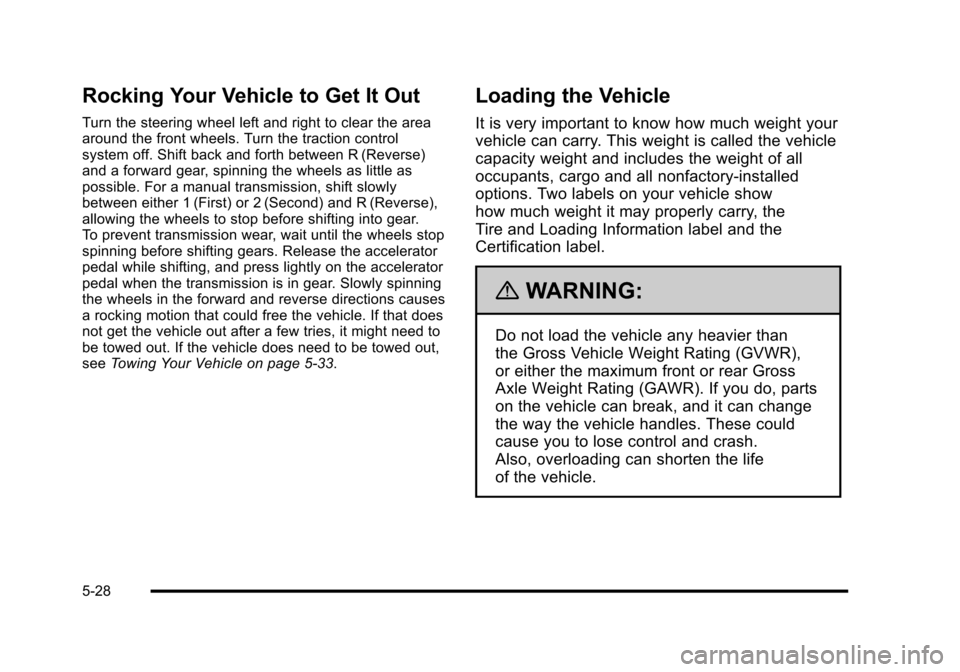
Rocking Your Vehicle to Get It Out
Turn the steering wheel left and right to clear the area
around the front wheels. Turn the traction control
system off. Shift back and forth between R (Reverse)
and a forward gear, spinning the wheels as little as
possible. For a manual transmission, shift slowly
between either 1 (First) or 2 (Second) and R (Reverse),
allowing the wheels to stop before shifting into gear.
To prevent transmission wear, wait until the wheels stop
spinning before shifting gears. Release the accelerator
pedal while shifting, and press lightly on the accelerator
pedal when the transmission is in gear. Slowly spinning
the wheels in the forward and reverse directions causes
a rocking motion that could free the vehicle. If that does
not get the vehicle out after a few tries, it might need to
be towed out. If the vehicle does need to be towed out,
see Towing Your Vehicle on page 5‑33.
Loading the Vehicle
It is very important to know how much weight your
vehicle can carry. This weight is called the vehicle
capacity weight and includes the weight of all
occupants, cargo and all nonfactory‐installed
options. Two labels on your vehicle show
how much weight it may properly carry, the
Tire and Loading Information label and the
Certification label.
{WARNING:
Do not load the vehicle any heavier than
the Gross Vehicle Weight Rating (GVWR),
or either the maximum front or rear Gross
Axle Weight Rating (GAWR). If you do, parts
on the vehicle can break, and it can change
the way the vehicle handles. These could
cause you to lose control and crash.
Also, overloading can shorten the life
of the vehicle.
5-28
Page 308 of 472
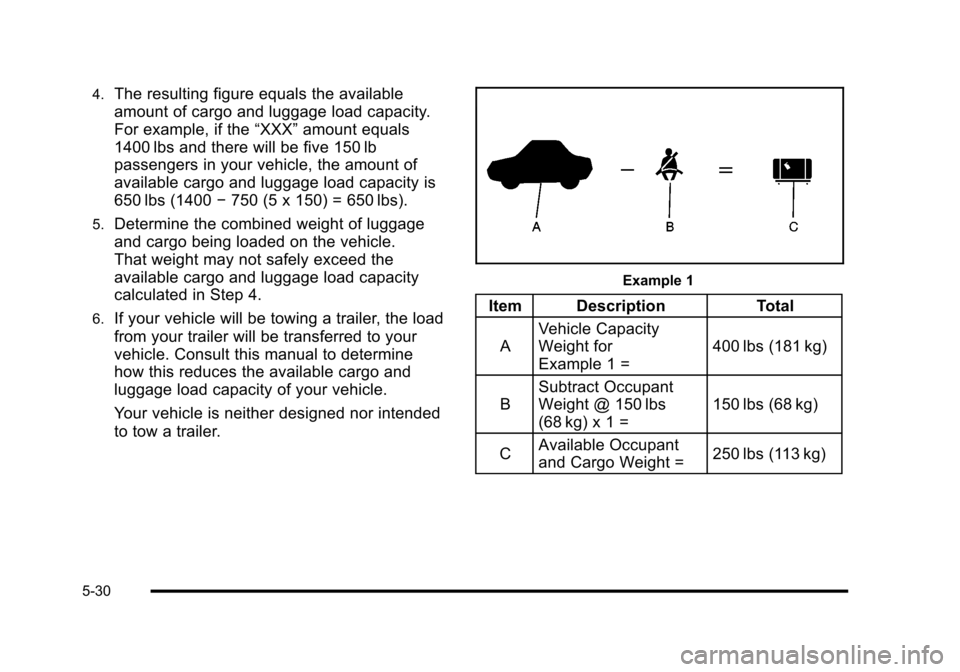
4.The resulting figure equals the available
amount of cargo and luggage load capacity.
For example, if the “XXX”amount equals
1400 lbs and there will be five 150 lb
passengers in your vehicle, the amount of
available cargo and luggage load capacity is
650 lbs (1400 −750 (5 x 150) = 650 lbs).
5.Determine the combined weight of luggage
and cargo being loaded on the vehicle.
That weight may not safely exceed the
available cargo and luggage load capacity
calculated in Step 4.
6.If your vehicle will be towing a trailer, the load
from your trailer will be transferred to your
vehicle. Consult this manual to determine
how this reduces the available cargo and
luggage load capacity of your vehicle.
Your vehicle is neither designed nor intended
to tow a trailer.
Example 1
Item Description Total
A Vehicle Capacity
Weight for
Example 1 = 400 lbs (181 kg)
B Subtract Occupant
Weight @ 150 lbs
(68 kg) x 1 = 150 lbs (68 kg)
C Available Occupant
and Cargo Weight =
250 lbs (113 kg)
5-30
Page 311 of 472
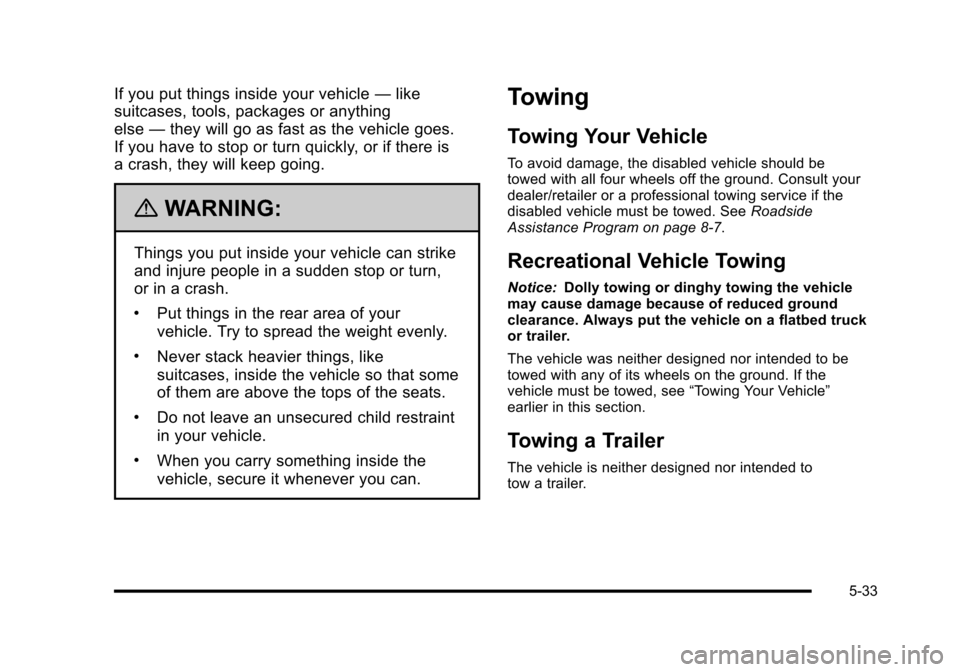
If you put things inside your vehicle—like
suitcases, tools, packages or anything
else —they will go as fast as the vehicle goes.
If you have to stop or turn quickly, or if there is
a crash, they will keep going.
{WARNING:
Things you put inside your vehicle can strike
and injure people in a sudden stop or turn,
or in a crash.
.Put things in the rear area of your
vehicle. Try to spread the weight evenly.
.Never stack heavier things, like
suitcases, inside the vehicle so that some
of them are above the tops of the seats.
.Do not leave an unsecured child restraint
in your vehicle.
.When you carry something inside the
vehicle, secure it whenever you can.
Towing
Towing Your Vehicle
To avoid damage, the disabled vehicle should be
towed with all four wheels off the ground. Consult your
dealer/retailer or a professional towing service if the
disabled vehicle must be towed. See Roadside
Assistance Program on page 8‑7.
Recreational Vehicle Towing
Notice: Dolly towing or dinghy towing the vehicle
may cause damage because of reduced ground
clearance. Always put the vehicle on a flatbed truck
or trailer.
The vehicle was neither designed nor intended to be
towed with any of its wheels on the ground. If the
vehicle must be towed, see “Towing Your Vehicle”
earlier in this section.
Towing a Trailer
The vehicle is neither designed nor intended to
tow a trailer.
5-33
Page 428 of 472
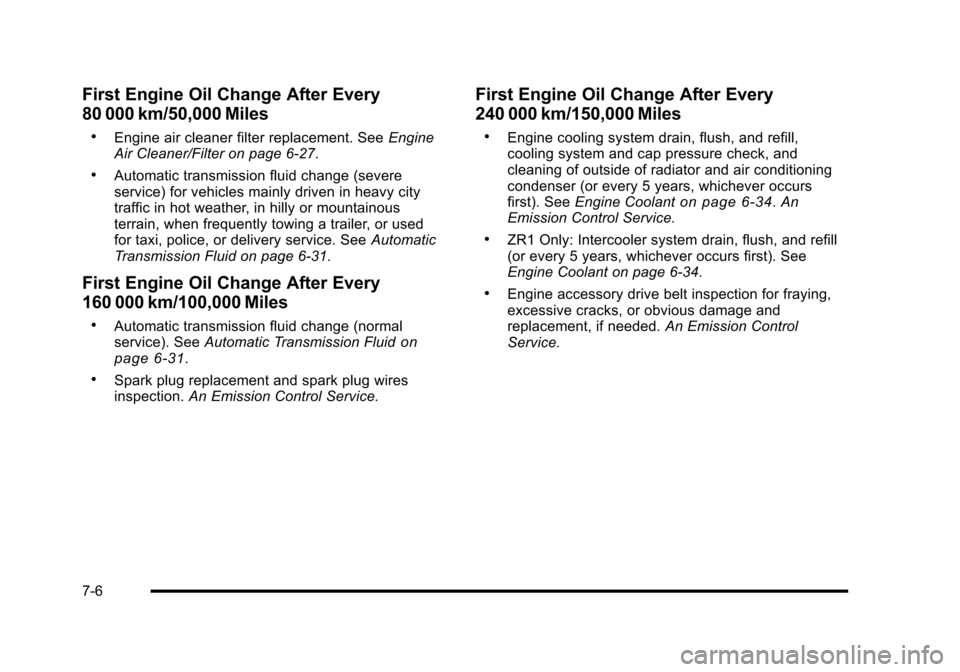
First Engine Oil Change After Every
80 000 km/50,000 Miles
.Engine air cleaner filter replacement. See Engine
Air Cleaner/Filter on page 6‑27.
.Automatic transmission fluid change (severe
service) for vehicles mainly driven in heavy city
traffic in hot weather, in hilly or mountainous
terrain, when frequently towing a trailer, or used
for taxi, police, or delivery service. See Automatic
Transmission Fluid on page 6‑31.
First Engine Oil Change After Every
160 000 km/100,000 Miles
.Automatic transmission fluid change (normal
service). See Automatic Transmission Fluidon
page 6‑31.
.Spark plug replacement and spark plug wires
inspection. An Emission Control Service.
First Engine Oil Change After Every
240 000 km/150,000 Miles
.Engine cooling system drain, flush, and refill,
cooling system and cap pressure check, and
cleaning of outside of radiator and air conditioning
condenser (or every 5 years, whichever occurs
first). See Engine Coolant
on page 6‑34.An
Emission Control Service.
.ZR1 Only: Intercooler system drain, flush, and refill
(or every 5 years, whichever occurs first). See
Engine Coolant on page 6‑34.
.Engine accessory drive belt inspection for fraying,
excessive cracks, or obvious damage and
replacement, if needed. An Emission Control
Service.
7-6
Page 447 of 472
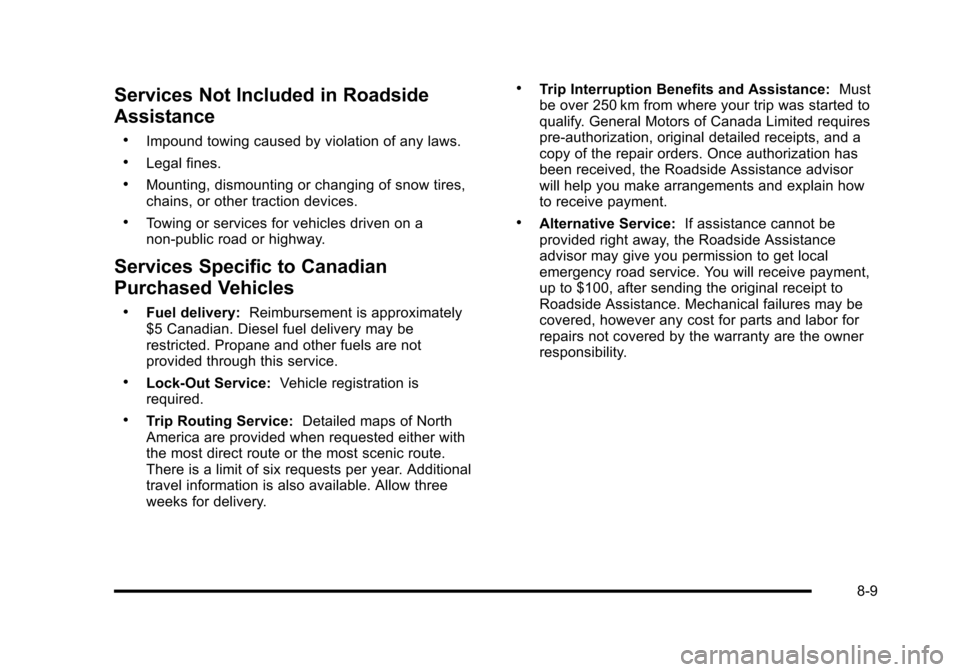
Services Not Included in Roadside
Assistance
.Impound towing caused by violation of any laws.
.Legal fines.
.Mounting, dismounting or changing of snow tires,
chains, or other traction devices.
.Towing or services for vehicles driven on a
non-public road or highway.
Services Specific to Canadian
Purchased Vehicles
.Fuel delivery: Reimbursement is approximately
$5 Canadian. Diesel fuel delivery may be
restricted. Propane and other fuels are not
provided through this service.
.Lock-Out Service: Vehicle registration is
required.
.Trip Routing Service: Detailed maps of North
America are provided when requested either with
the most direct route or the most scenic route.
There is a limit of six requests per year. Additional
travel information is also available. Allow three
weeks for delivery.
.Trip Interruption Benefits and Assistance: Must
be over 250 km from where your trip was started to
qualify. General Motors of Canada Limited requires
pre-authorization, original detailed receipts, and a
copy of the repair orders. Once authorization has
been received, the Roadside Assistance advisor
will help you make arrangements and explain how
to receive payment.
.Alternative Service: If assistance cannot be
provided right away, the Roadside Assistance
advisor may give you permission to get local
emergency road service. You will receive payment,
up to $100, after sending the original receipt to
Roadside Assistance. Mechanical failures may be
covered, however any cost for parts and labor for
repairs not covered by the warranty are the owner
responsibility.
8-9
Page 452 of 472

.If your vehicle cannot be driven, know where the
towing service will be taking it. Get a card from the
tow truck operator or write down the driver's name,
the service's name, and the phone number.
.Remove any valuables from your vehicle before
it is towed away. Make sure this includes your
insurance information and registration if you keep
these items in your vehicle.
.Gather the important information you will need from
the other driver. Things like name, address, phone
number, driver's license number, vehicle license
plate, vehicle make, model and model year,
Vehicle Identification Number (VIN), insurance
company and policy number, and a general
description of the damage to the other vehicle.
.If possible, call your insurance company from the
scene of the crash. They will walk you through
the information they will need. If they ask for a
police report, phone or go to the police department
headquarters the next day and you can get a
copy of the report for a nominal fee. In some
states/provinces with “no fault”insurance laws, a
report may not be necessary. This is especially
true if there are no injuries and both vehicles are
driveable.
.Choose a reputable collision repair facility for
your vehicle. Whether you select a dealer/retailer
or a private collision repair facility to fix the
damage, make sure you are comfortable with
them. Remember, you will have to feel comfortable
with their work for a long time.
.Once you have an estimate, read it carefully and
make sure you understand what work will be
performed on your vehicle. If you have a question,
ask for an explanation. Reputable shops welcome
this opportunity.
8-14
Page 468 of 472

Passenger Airbag Status Indicator . . . . . . . . . . . . . . . . . 4-34
Passenger Compartment Air Filter . . . . . . . . . . . . . . . . . 4-28
Passenger Sensing System . . . . . . . . . . . . . . . . . . . . . . . 2-53
Passing . . . . . . . . . . . . . . . . . . . . . . . . . . . . . . . . . . . . . . . . . . . . 5-18
Perchlorate Materials Requirements, California . . . . . .6-4
Phone Bluetooth
®. . . . . . . . . . . . . . . . . . . . . . . . . . . . . . . . . . . . . . . . 4-96
Power Door Locks . . . . . . . . . . . . . . . . . . . . . . . . . . . . . . . . . . . . . . . 3-12
Electrical System . . . . . . . . . . . . . . . . . . . . . . . . . . . . . . . .6-100
Lumbar and Side Bolsters . . . . . . . . . . . . . . . . . . . . . . . . . 2-3
Retained Accessory (RAP) . . . . . . . . . . . . . . . . . . . . . . . 3-24
Seat . . . . . . . . . . . . . . . . . . . . . . . . . . . . . . . . . . . . . . . . . . . . . . . 2-3
Steering Fluid . . . . . . . . . . . . . . . . . . . . . . . . . . . . . . . . . . . . . 6-41
Windows . . . . . . . . . . . . . . . . . . . . . . . . . . . . . . . . . . . . . . . . . 3-17
Pregnancy, Using Safety Belts . . . . . . . . . . . . . . . . . . . . . 2-25
Privacy . . . . . . . . . . . . . . . . . . . . . . . . . . . . . . . . . . . . . . . . . . . . 8-18
Navigation System . . . . . . . . . . . . . . . . . . . . . . . . . . . . . . . . 8-19
OnStar . . . . . . . . . . . . . . . . . . . . . . . . . . . . . . . . . . . . . . . . . . . 8-19
Radio Frequency Identification (RFID) . . . . . . . . . . . . 8-20
Program
Courtesy Transportation . . . . . . . . . . . . . . . . . . . . . . . . . . 8-10
Programmable Automatic Door Unlock . . . . . . . . . . . . 3-13
Proposition 65 Warning, California . . . . . . . . . . . . . . . . . . .6-4
R
Racing or Other Competitive Driving . . . . . . . . . . . . . . . 5-19
Radio Frequency Identification (RFID) . . . . . . . . . . . . . . . . . . . . . . . . . . . . . . 8-20
Statement . . . . . . . . . . . . . . . . . . . . . . . . . . . . . . . . . . . . . . . . 8-20
Radio(s) . . . . . . . . . . . . . . . . . . . . . . . . . . . . . . . . . . . . . . . . . . . 4-81
Radios Navigation/Radio System, see NavigationManual . . . . . . . . . . . . . . . . . . . . . . . . . . . . . . . . . . . . . . . . . . 4-96
Reception . . . . . . . . . . . . . . . . . . . . . . . . . . . . . . . . . . . . . . .4-108
Setting the Clock . . . . . . . . . . . . . . . . . . . . . . . . . . . . . . . . . 4-80
Theft-Deterrent . . . . . . . . . . . . . . . . . . . . . . . . . . . . . . . . . .4-106
Reading Lamps . . . . . . . . . . . . . . . . . . . . . . . . . . . . . . . . . . . . 4-15
Rear Axle . . . . . . . . . . . . . . . . . . . . . . . . . . . . . . . . . . . . . . . . . . 6-55 Limited-Slip . . . . . . . . . . . . . . . . . . . . . . . . . . . . . . . . . . . . . . . 5-14
Rear Storage . . . . . . . . . . . . . . . . . . . . . . . . . . . . . . . . . . . . . . 3-51
Rearview Mirrors
Automatic Dimming . . . . . . . . . . . . . . . . . . . . . . . . . . . . . . . 3-39
Reclining Seatbacks . . . . . . . . . . . . . . . . . . . . . . . . . . . . . . . . .2-6
Recommended Fluids and Lubricants . . . . . . . . . . . . . 7-10
Recreational Vehicle Towing . . . . . . . . . . . . . . . . . . . . . . . 5-33
Reimbursement Program, GM Mobility . . . . . . . . . . . . . . .8-7
Remote, Keyless Access System . . . . . . . . . . . . . . . . . . . .3-5
Removing the Roof Panel . . . . . . . . . . . . . . . . . . . . . . . . . 3-54
i - 10
Page 471 of 472

Tires (cont.) High-Speed Operation . . . . . . . . . . . . . . . . . . . . . . . . . . . . 6-72
If a Tire Goes Flat . . . . . . . . . . . . . . . . . . . . . . . . . . . . . . . . 6-89
Inflation - Tire Pressure . . . . . . . . . . . . . . . . . . . . . . . . . . . 6-70
Inspection and Rotation . . . . . . . . . . . . . . . . . . . . . . . . . . 6-76
Lifting the Vehicle . . . . . . . . . . . . . . . . . . . . . . . . . . . . . . . . . 6-84
Pressure Light . . . . . . . . . . . . . . . . . . . . . . . . . . . . . . . . . . . . 4-40
Pressure Monitor Operation . . . . . . . . . . . . . . . . . . . . . . 6-74
Pressure Monitor System . . . . . . . . . . . . . . . . . . . . . . . . . 6-72
Run-Flat . . . . . . . . . . . . . . . . . . . . . . . . . . . . . . . . . . . . . . . . . . 6-69
Sidewall Labeling . . . . . . . . . . . . . . . . . . . . . . . . . . . . . . . . . 6-64
Terminology and Definitions . . . . . . . . . . . . . . . . . . . . . . 6-66
Uniform Tire Quality Grading . . . . . . . . . . . . . . . . . . . . . 6-79
Wheel Alignment and Tire Balance . . . . . . . . . . . . . . . 6-81
Wheel Replacement . . . . . . . . . . . . . . . . . . . . . . . . . . . . . . 6-81
When It Is Time for New Tires . . . . . . . . . . . . . . . . . . . . 6-76
Winter . . . . . . . . . . . . . . . . . . . . . . . . . . . . . . . . . . . . . . . . . . . . 6-63
Towing
Recreational Vehicle . . . . . . . . . . . . . . . . . . . . . . . . . . . . . . 5-33
Towing a Trailer . . . . . . . . . . . . . . . . . . . . . . . . . . . . . . . . . . 5-33
Your Vehicle . . . . . . . . . . . . . . . . . . . . . . . . . . . . . . . . . . . . . . 5-33
Traction Active Handling System . . . . . . . . . . . . . . . . . . . . . . . . . . . 5-8
Control System (TCS) . . . . . . . . . . . . . . . . . . . . . . . . . . . . . 5-6
Control System Warning Light . . . . . . . . . . . . . . . . . . . . 4-38
Limited-Slip Rear Axle . . . . . . . . . . . . . . . . . . . . . . . . . . . . 5-14
Selective Ride Control . . . . . . . . . . . . . . . . . . . . . . . . . . . . 5-14 Transmission
Fluid, Automatic . . . . . . . . . . . . . . . . . . . . . . . . . . . . . . . . . . 6-31
Fluid, Manual . . . . . . . . . . . . . . . . . . . . . . . . . . . . . . . . . . . . . 6-31
One-to-Four Shift Light . . . . . . . . . . . . . . . . . . . . . . . . . . . 4-36
Transmission Operation, Automatic . . . . . . . . . . . . . . . . 3-26
Transmission Operation, Manual . . . . . . . . . . . . . . . . . . 3-32
Transportation Program, Courtesy . . . . . . . . . . . . . . . . . 8-10
Trunk/Hatch . . . . . . . . . . . . . . . . . . . . . . . . . . . . . . . . . . . . . . . 3-14
Turn and Lane-Change Signals . . . . . . . . . . . . . . . . . . . . . .4-5
Turn Signal/Multifunction Lever . . . . . . . . . . . . . . . . . . . . . .4-4
Twilight Sentinel
®. . . . . . . . . . . . . . . . . . . . . . . . . . . . . . . . . . 4-14
U
Uniform Tire Quality Grading . . . . . . . . . . . . . . . . . . . . . . 6-79
Universal Home Remote System . . . . . . . . . . . . . . . . . . 3-42 Operation . . . . . . . . . . . . . . . . . . . . . . . . . . . . . . . . . . . . . . . . . 3-43
V
Vehicle Control . . . . . . . . . . . . . . . . . . . . . . . . . . . . . . . . . . . . . . . . . . . . 5-3
Loading . . . . . . . . . . . . . . . . . . . . . . . . . . . . . . . . . . . . . . . . . . . 5-28
Parking Your . . . . . . . . . . . . . . . . . . . . . . . . . . . . . . . . . . . . . . 3-36
Running While Parked . . . . . . . . . . . . . . . . . . . . . . . . . . . . 3-38
Symbols . . . . . . . . . . . . . . . . . . . . . . . . . . . . . . . . . . . . . . . . . . . . . iv
Vehicle Data Recording and Privacy . . . . . . . . . . . . . . . 8-18
i - 13